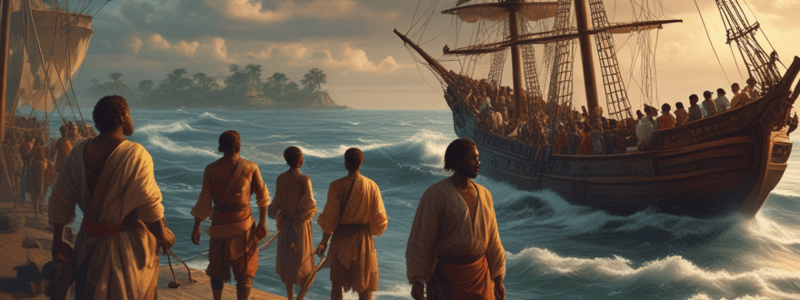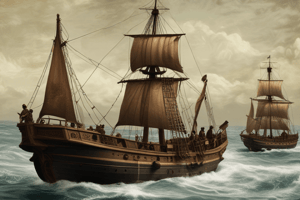Podcast
Questions and Answers
Which of the following was NOT an advantage of using African labor for the Europeans in the Americas?
Which of the following was NOT an advantage of using African labor for the Europeans in the Americas?
- Knowledge of farming
- Ease of identification by skin color if they escaped
- Familiarity with the land (correct)
- Immunity to European diseases
What was the primary motivation for the Europeans to engage in the Atlantic slave trade?
What was the primary motivation for the Europeans to engage in the Atlantic slave trade?
- To establish trade routes for gold and spices
- To obtain a workforce for their colonies in the Americas (correct)
- To spread Christianity to Africa
- To conquer and colonize African territories
Approximately how many Africans were forcibly transported to the Americas as part of the Atlantic slave trade by 1870?
Approximately how many Africans were forcibly transported to the Americas as part of the Atlantic slave trade by 1870?
- 3.5 million
- 9.5 million (correct)
- 1.3 million
- Over 15 million
Which of the following statements about the conditions on slave ships during the Middle Passage is true?
Which of the following statements about the conditions on slave ships during the Middle Passage is true?
What was the primary cash crop cultivated by slave labor in the Americas?
What was the primary cash crop cultivated by slave labor in the Americas?
Which European nation was the first to abolish the slave trade and later slavery itself in its colonies?
Which European nation was the first to abolish the slave trade and later slavery itself in its colonies?
How did the Atlantic slave trade impact the development of American culture?
How did the Atlantic slave trade impact the development of American culture?
What was the impact of the Atlantic slave trade on Africa?
What was the impact of the Atlantic slave trade on Africa?
Which of the following best describes the Triangle Trade?
Which of the following best describes the Triangle Trade?
Based on Olaudah Equiano's account, what was a significant consequence of the conditions on slave ships during the Middle Passage?
Based on Olaudah Equiano's account, what was a significant consequence of the conditions on slave ships during the Middle Passage?
Which of the following was NOT a consequence of the Atlantic Slave Trade in the Americas?
Which of the following was NOT a consequence of the Atlantic Slave Trade in the Americas?
Which of the following best describes a consequence of the Atlantic Slave Trade in Africa?
Which of the following best describes a consequence of the Atlantic Slave Trade in Africa?
Based on the information provided, which of the following statements is true?
Based on the information provided, which of the following statements is true?
Which of the following was a contributing factor to the Atlantic Slave Trade, according to the information provided?
Which of the following was a contributing factor to the Atlantic Slave Trade, according to the information provided?
According to the information provided, which of the following statements is NOT true about the conditions on slave ships during the Middle Passage?
According to the information provided, which of the following statements is NOT true about the conditions on slave ships during the Middle Passage?
Flashcards are hidden until you start studying
Study Notes
The Atlantic Slave Trade
- The history of slavery dates back to around 3500 BCE, with captives of war becoming slaves in most cultures.
- From 650-1600 CE, Muslims bought and sold captives as slaves from wars in Africa and the Middle East.
- The Portuguese traded with Africans from 1400 onwards, initially interested in gold but later in slaves.
Need for African Labor
- After colonization, Europeans needed labor to cultivate lands and replace native populations devastated by disease.
- Advantages of using African labor included:
- Immunity to European diseases
- Knowledge of farming
- Less likely to escape, due to unfamiliarity with the land
- Skin color, making it easier to find escaped slaves
Growth of the Atlantic Slave Trade
- From 1500-1600, around 300,000 slaves were taken from Africa.
- From 1600-1700, approximately 1.3 million slaves were taken.
- By 1870, over 9.5 million slaves had been brought to the Americas.
European Involvement
- Spain and Portugal led the Slave Trade in the Caribbean and South America, driven by the need for cheap labor and cash crops like sugar, tobacco, and cotton.
- England was involved in the Slave Trade from 1690-1807, during which 1.7 million Africans were taken.
- England abolished the Slave Trade in 1807 and abolished slavery completely in 1834, freeing around 800,000 Africans in her colonies.
The Middle Passage and the Triangle Trade
- The Middle Passage refers to the journey from Africa to the Americas, which resulted in the deaths of many enslaved Africans.
- The Triangle Trade involved the exchange of goods between Europe, Africa, and the Americas, with captured Africans being sold to the Americas.
African Cooperation and Resistance
- Some Africans captured and sold other Africans to Europeans, motivated by greed, power, and local conflicts.
- There was also opposition to slavery from Africans.
Consequences of the Atlantic Slave Trade
- The Slave Trade led to the forced migration of millions of Africans to the Americas.
- The experience of enslaved Africans, like Olaudah Equiano, was marked by brutality, inhumane treatment, and the loss of identity and culture.
Studying That Suits You
Use AI to generate personalized quizzes and flashcards to suit your learning preferences.




